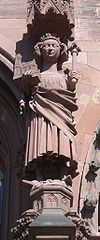Basel Minster


Basel Minster (German: Basler Münster) is a religious building in the
The original cathedral was built between 1019 and 1500 in
One of the main landmarks and tourist attractions of Basel, it adds definition to the cityscape with its red
Building history
Early structures
The hill on which the Minster is located today was a
The first
Second church structure – the Heinrich Münster

Built on the old foundations of the Haito Minster some time after the turn of the first millennium a new building in the early Romanesque style of the Ottonian period was built by order of Bishop Adalberto II (c. 999–1025). Sometimes called “Adalberto Cathedral”, the three-nave cathedral is actually named after its patron Emperor Henry II, in German “Heinrich”. The cathedral is dedicated to Henry II and his wife Kunigunde. The prince-bishop governed the city as representative of the Emperor who gained possession of Basel in 1006.
Excavations from 1973 to 1974 prove that the crypt of this building,
Third church structure – late Romanesque

The building as it stands today dates back for the most part to the late
Even though supported by massive
Important historical events
Pope's Election at Basel Cathedral
In 1424,
Destruction of religious paintings
During the
A group of 40 armed men is said to have ascended to the minster from the crowded market place at approximately 1 pm on 9 February 1529. After a first attack on the church, during which an
The impressive treasure of the minster was saved and remained complete until the Canton of Basel was split into "half-cantons" in 1833. In the 1850s new stained glass windows by Franz Xaver Eggert have been installed.
Architecture
Georgsturm and Martinsturm

The main front which points at the west is bestrided by two towers. The northern tower is called Georgsturm (64.2 m) and the southern tower is called Martinsturm (62.7 m). The towers are named after
After a heavy
Both of the steeples consist of three lower, undivided
Main Porch

An empty column, which originally carried a statue of the Virgin Mary, is situated between the doors of the main
The benefactors Henry II and his wife, Empress Kunigunde, are portrayed left of the main porch. In the portrait, the emperor, depicted as a surprisingly young and beardless man, is carrying a church model in his arms, which identifies him as the benefactor. Only after the renovation of the exterior (1880 – 1980), the empress was given a cross as another symbol of identification. Originally, she was carrying gloves.
On the right one can see the pictures of a
While the virgin smiles and starts to undress, toads and snakes crawl in the back of the seducer. They should embody the evil. The image dates back to roughly 1280. The statues and brickwork of the cathedral consist of red sandstone which was found in
Uses
Until the Reformation, Basel Minster was the church of the bishop and the main church of the
On 9 February 1529, all religious images were removed from the cathedral and the Minster became the main congregation in the city of the
Burials

In the choir passage is the sarcophagus of Queen Anne of Habsburg and her son Charles. She had married in 1254 as Gertrude of Hohenberg the future King Rudolf of Habsburg[6] and died in 1281 in Vienna. From there, her body was transferred to Basel. The bones found in her grave (a woman, a child, a man) were transferred in 1770 to Saint Blaise Abbey, Black Forest; later on to Saint Paul's Abbey, Lavanttal.
Gallery
References
- Except for some text in the introductory paragraph, this article is a translation of the German language article.
Footnotes
- Swiss inventory of cultural property of national and regional significance(1995), p. 75.
- ISBN 978-3-7913-3580-3, pp. 346–47.
- ^ Basel Münster website - Architecture 12th and 13th centuries (in German) accessed 29 June 2014
- ^ Basel Münster website - Architecture 14th and 15th centuries Archived February 28, 2012, at the Wayback Machine (in German) accessed 4 May 2012
- ^ Rey, Karin (26 December 2019). "Das versteckte Porträt am Martinsturm". Basler Zeitung (in German). Retrieved 2022-07-06.
- ^ Grütter, Daniel (2002). "Das Grabmal der Königin Anna von Habsburg im Basler Münster". E-Periodica. p. 60.
External links
- "Baugeschichte des Basler Münsters" (PDF). , Universität Freiburg seminar paper, Oct. 1979, 38 pages. Retrieved 28 March 2014.














